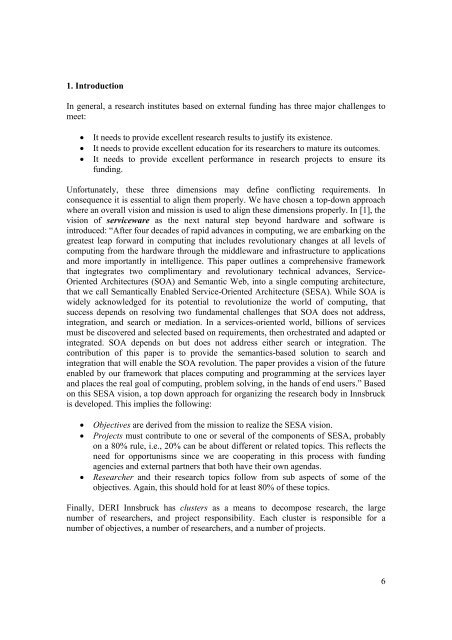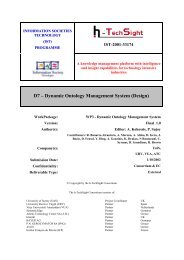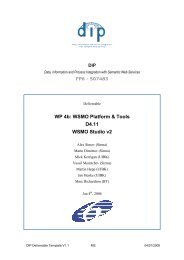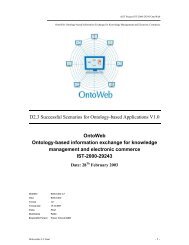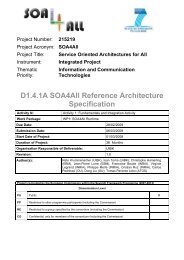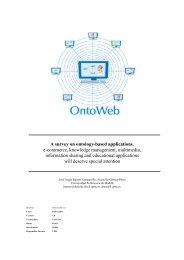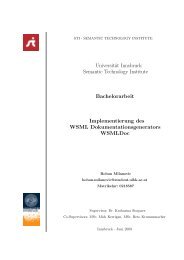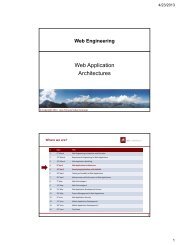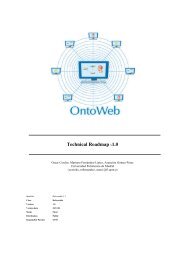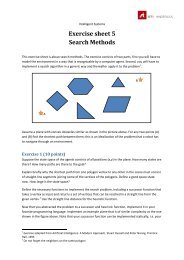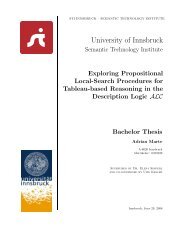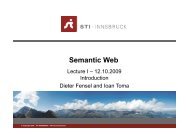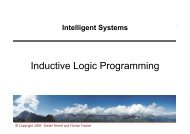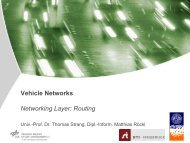- Page 1 and 2: DERI INNSBRUCK Leopold-Franzens Uni
- Page 3 and 4: Abstract. A large research body nee
- Page 5: 4.3.9. SUPER Martin ...............
- Page 9 and 10: 2. Survey We will survey objectives
- Page 11 and 12: e mainly (1) actual ontologies and
- Page 13 and 14: etween a requestor and a provider o
- Page 15 and 16: orchestrates these atomic pieces in
- Page 17 and 18: addition, all efforts in projects s
- Page 19 and 20: PhD Process: The process can be rou
- Page 21 and 22: . Which problems are still unsolved
- Page 23 and 24: Methods Structure Evaluation method
- Page 25 and 26: 4.3. Senior researchers Senior Rese
- Page 27 and 28: The Formal Languages component will
- Page 29 and 30: Future Steps Publications different
- Page 31 and 32: 2. Determines the legal instances f
- Page 33 and 34: identified in task 1 The current la
- Page 35 and 36: Students: - Holger Lausen Livia Pre
- Page 37 and 38: epresentational adequacy of the int
- Page 39 and 40: Jos de Bruijn, Enrico Franconi, and
- Page 41 and 42: • Top-Down: QsQ evaluation; • M
- Page 43 and 44: Publications Software releases Sinc
- Page 45 and 46: 3.3.2. Knowledge Web Name Acronym F
- Page 47 and 48: Mission Students: Nathalie Steinmet
- Page 49 and 50: Deliverables • D3.1.1 Representat
- Page 51 and 52: terms of m*m) Duration 18 months 20
- Page 53 and 54: 3.4.1. Student Researchers Student
- Page 55 and 56: Progress towards PhD rules in order
- Page 57 and 58:
3.4.2.2. Jos de Bruijn Name Jos the
- Page 59 and 60:
[3] Jos de Bruijn, Holger Lausen, A
- Page 61 and 62:
13. Holger Lausen, Jos de Bruijn, A
- Page 63 and 64:
32. Jos de Bruijn, Dieter Fensel, U
- Page 65 and 66:
3.4.2.4. Cristina Feier Name Cristi
- Page 67 and 68:
Progress towards PhD Implementation
- Page 69 and 70:
3.4.2.5. Uwe Keller Name Uwe Keller
- Page 71 and 72:
thoroughly develops the justificati
- Page 73 and 74:
4011 of Lecture Notes in Computer S
- Page 75 and 76:
schemes like UNSPC. Respectively it
- Page 77 and 78:
Vladimir Alexiev, Michael Breu, Jos
- Page 79 and 80:
3.4.2.7. Ruzica Piskac Name Ruzica
- Page 81 and 82:
3.4.2.8. Richard Pöttler Name Rich
- Page 83 and 84:
2. Motivation - why choreography in
- Page 85 and 86:
Publications WSMO4J - Input in the
- Page 87 and 88:
1st WSMO Implementation Workshop, F
- Page 89 and 90:
Progress towards Habil reasoning wi
- Page 91 and 92:
Extending Conceptual Logic Programs
- Page 93 and 94:
4. Semantics in Business Informatio
- Page 95 and 96:
propose/provide infrastructure •
- Page 97 and 98:
Electronic Markets and Electronic P
- Page 99 and 100:
Martin Hepp, Jörg Leukel, and Volk
- Page 101 and 102:
Michal Zaremba.: Architecture tasks
- Page 103 and 104:
Budget (in terms of m*m) retrieval.
- Page 105 and 106:
ths budget Duration 48 months 10/04
- Page 107 and 108:
Budget (in terms of m*m) validation
- Page 109 and 110:
Month 24 • D4.2 Supplier Ontology
- Page 111 and 112:
thus the entire content organizatio
- Page 113 and 114:
4.4. Staff Here we discuss student,
- Page 115 and 116:
of the media production workflow an
- Page 117 and 118:
4.4.2.2. Jan Henke Name Jan Henke E
- Page 119 and 120:
Implementatios Publications meant t
- Page 121 and 122:
M. Burstein, C. Bussler, M. Pistore
- Page 123 and 124:
4.4.2.5. Francois Scharffe Name Fra
- Page 125 and 126:
-Adapters -WSMO4j -OWL API -Mapping
- Page 127 and 128:
4.4.2.7. Michael Stollberg Name Mic
- Page 129 and 130:
WSCOBPM, BPS, Nancy, France, Septem
- Page 131 and 132:
Fred. Proceedings of the Workshop o
- Page 133 and 134:
versioning of various ontologies ar
- Page 135 and 136:
S. Arroyo, R. Lara, J. Gomez, D. Be
- Page 137 and 138:
view. Journal of Information Scienc
- Page 139 and 140:
content. 1.2 Community-driven Ontol
- Page 141 and 142:
Hepp, Martin; Doerflein, Michael: K
- Page 143 and 144:
Architectural Approaches, in: Proce
- Page 145 and 146:
5. Semantic Execution Environment C
- Page 147 and 148:
Current responsibilities of particu
- Page 149 and 150:
statement Web site Leader Cluster T
- Page 151 and 152:
WSMX. With the WSMT the user is abl
- Page 153 and 154:
Workshops Adrian Mocan and Emilia C
- Page 155 and 156:
In this context, the heterogeneity
- Page 157 and 158:
certain cases to be structurally tr
- Page 159 and 160:
management techniques such as sched
- Page 161 and 162:
Deliverables Remaining: • D1.I-6
- Page 163 and 164:
Mission Budget (in terms of m*m) Ad
- Page 165 and 166:
Objective Website Team Semantic Exe
- Page 167 and 168:
Major tasks • Mediation within Tr
- Page 169 and 170:
5.4.2.1. Emilia Cimpian Name Emilia
- Page 171 and 172:
Web Services, European Workshop on
- Page 173 and 174:
Publications -Implemented WSML & OW
- Page 175 and 176:
“Enterprise Information Integrati
- Page 177 and 178:
Sun Hongwei, Zhang Shusheng, Zhou J
- Page 179 and 180:
(to appear) Zhang Chao, Zhang Shush
- Page 181 and 182:
5.4.2.4. Mick Kerrigan Name Mick Ke
- Page 183 and 184:
expressions graphically. Further re
- Page 185 and 186:
Mick Kerrigan (Masters Thesis), WSM
- Page 187 and 188:
Research topic Deliverables - D2.4.
- Page 189 and 190:
model of this mediation solution. T
- Page 191 and 192:
5.4.2.6. Omair Shafiq Name Omair Sh
- Page 193 and 194:
Research topic Grid Services) T3.1:
- Page 195 and 196:
concepts and technologies (which ca
- Page 197 and 198:
5.4.2.7. Adina Sirbu Name Adina Sir
- Page 199 and 200:
5.4.2.8. Zhixian Yan Name Zhixian Y
- Page 201 and 202:
still do not have a detailed plan w
- Page 203 and 204:
Progress towards Habil semantically
- Page 205 and 206:
T. Haselwanter, Maciej Zaremba and
- Page 207 and 208:
6. Ubiquitous Services Cluster (Ubi
- Page 209 and 210:
Contributing projects Current Statu
- Page 211 and 212:
TripleS Data Grounding (Adrian): pl
- Page 213 and 214:
Figure 6.2.3.1. TSC and WSMX in WSM
- Page 215 and 216:
TSC: Reto Krummenacher, Francisco M
- Page 217 and 218:
- Junior Researchers: Tobias Bürge
- Page 219 and 220:
• D7.3 Workshop user community
- Page 221 and 222:
6.4. Staff Here we discuss student,
- Page 223 and 224:
on Context-Aware Mobile Systems (CA
- Page 225 and 226:
with existing technologies from the
- Page 227 and 228:
similar technologies could also ent
- Page 229 and 230:
6.4.2.3. Ioan Toma Name Ioan Toma E
- Page 231 and 232:
substitution. In the field of softw
- Page 233 and 234:
Ioan Toma, Kashif Iqbal, Matthew Mo
- Page 235 and 236:
Toma: Web Service Discovery - A Rea
- Page 237 and 238:
Execution Environment), 2004. 6.4.3
- Page 239 and 240:
6.4.3.3. Thomas Strang Name Thomas
- Page 241 and 242:
Krummenacher, Reto; Strang, Thomas
- Page 243 and 244:
Strang, Thomas; Linnhoff-Popien, Cl
- Page 245 and 246:
München, 2002-03-12 Angermann, Mic
- Page 247 and 248:
7. Beyond Research: Teaching, Busin
- Page 249 and 250:
WSMX Axel Polleres Thomas Haselwant
- Page 251 and 252:
The role of Non- Functional Propert
- Page 253 and 254:
makers should understand why their
- Page 255 and 256:
• 4.1.16 Prototype of core functi
- Page 257 and 258:
Team n/a Mission • Sustainability
- Page 259 and 260:
[11] E. Cimpian, A. Mocan, WSMX Pro
- Page 261 and 262:
[37] A. Haller: D13.6v0.1 WSMX Use
- Page 263 and 264:
Appendix Not yet assigned component
- Page 265 and 266:
functions in model checking [Kupfer
- Page 267 and 268:
al SPIN'06, Hoffmann et al, MoChArt
- Page 269 and 270:
Software releases FFv2.3: Basic ver
- Page 271 and 272:
J. Hoffmann, J. Porteous, L. Sebast
- Page 273 and 274:
J. Posteous, L. Sebastia, and J. Ho


